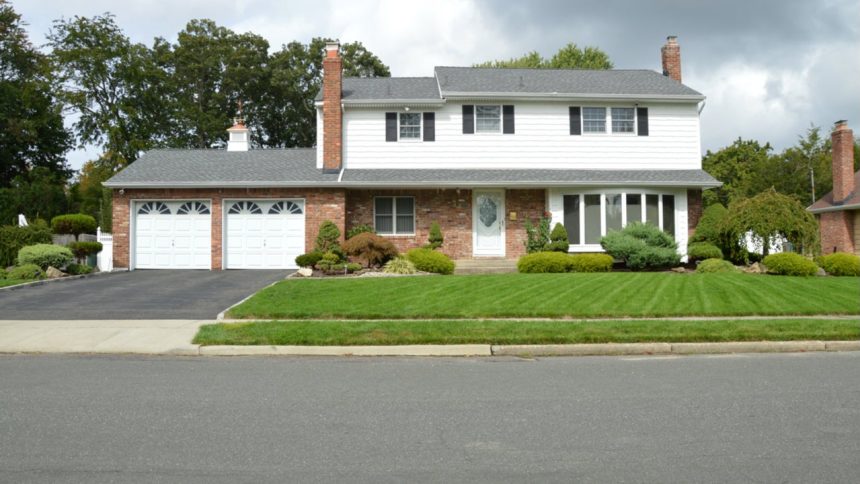Key takeaways
- A fixed-rate mortgage maintains a consistent interest rate throughout its entire term, whether it spans 30 years, 15 years, or any other time period.
- A fixed-rate mortgage provides a predictable monthly payment, contributing to a more stable housing cost.
- Even within the fixed-rate loan category, there are different options available.
Not all mortgages are created equal when it comes to the interest they charge: some offer fixed rates, while others have fluctuating rates. In the U.S., the most common loan type by far is the fixed-rate mortgage. Yet even with fixed-rate loans, there are a variety of options.
Read on to better understand what fixed-rate mortgages are, how they work, and how they differ from adjustable-rate mortgages.
What is a fixed-rate mortgage?
A fixed-rate mortgage means that the interest rate stays constant throughout the entire loan period, or term. These loans are popular because they provide predictability. With a fixed-rate mortgage, your monthly payment for principal and interest remains consistent, so you always know how much is due. Although some additional costs like homeowners insurance and property taxes may cause slight variations in your total monthly payment, the core loan payment remains the same, enabling you to budget and plan more efficiently.
While 30-year terms are the most common, you can also find options for 20-year, 15-year, and 10-year loans. Additionally, many lenders offer even more flexible terms ranging from eight years to 40 years.
How fixed-rate mortgages work
The prevailing mortgage rates that lenders advertise are always moving up and down due to several factors. So, you might see an offer for a 7.5 percent interest rate today and a 7.75 percent interest rate tomorrow. However, with a fixed-rate mortgage, once you lock in your rate and close on your home, that movement doesn’t impact you. No matter what happens after you secure your loan, your rate remains the same. In contrast, with adjustable-rate mortgages (ARMs), the interest rate can go up or down based on market conditions.
While a fixed-rate mortgage’s monthly payment amount stays the same, the breakdown of where those funds go — how much is paying down the principal versus how much is paying interest charges — varies based on the loan’s amortization schedule. At first, it’s going mostly towards interest, then gradually applies in increasing amounts to the principal.
For instance, if you make a 20 percent down payment on a $375,000 home and take out $300,000 30-year fixed-rate mortgage at 7.5 percent interest, your monthly payment (excluding insurance and taxes) would be $2,097 for the entire 30 years. In the first month, only about $220 of your payment would reduce the actual loan amount (principal), while the rest covers interest. Twenty years later, $984 (or nearly half) of your payment would be applied to the principal. By late 2044, less than half of the payment would be towards interest. This is how you build home equity, or outright ownership, in the property over time.
Bankrate insights
Fixed-rate mortgage example
Meet Jill, a newcomer to homebuying who’s ready to transition from renting. After doing some budgeting, Jill has figured out that she can comfortably handle about $1,200 each month for her mortgage, covering principal and interest.
By working in reverse from this monthly budget, we can estimate the amount Jill could potentially borrow with two different fixed-rate mortgages. (Note: We haven’t considered a down payment or closing costs in this example.)
| Amount | Fixed-rate | Term | Monthly payment |
|---|---|---|---|
| $175,000 | 7.57% | 30 years | $1,232 |
| $140,000 | 6.82% | 15 years | $1,244 |
For about the same monthly payment, Jill can borrow $35,000 more with a 30-year fixed loan compared to a 15-year loan.
Now, imagine that Jill’s budget and excellent credit enable her to select the $175,000 loan, regardless of the loan duration. If she decides on a 30-year fixed-rate mortgage, she’ll face a higher interest rate but gain the flexibility of a more extended repayment period. However, this convenience of a longer term comes with a significant downside — a considerably larger total cost in terms of interest charges:
| Amount | Fixed-rate | Term | Interst total |
|---|---|---|---|
| $175,000 | 7.57% | 30 years | $268,529 |
| $140,000 | 6.82% | 15 years | $83,976 |
If Jill can afford the higher monthly payments of a 15-year mortgage, she’ll save over $181,000 in interest. But if those monthly payments are unaffordable, she may be better off with the 30-year loan.
Using Bankrate’s mortgage calculator, here’s an amortization table showing how much Jill will pay over the life of a 30-year fixed-rate $175,000 mortgage loan at 7.57% that would hypothetically begin in January 2024:
| Date | Principal | Interest | Remaining balance |
|---|---|---|---|
| 2024 | $1,454.01 | $12,098.26 | $173,545.99 |
| 2025 | $3,159.23 | $25,177.33 | $171,840.77 |
| 2026 | $4,998.11 | $38,122.74 | $170,001.89 |
| 2027 | $6,981.13 | $50,924.02 | $168,018.87 |
| 2028 | $9,119.58 | $63,569.86 | $165,880.42 |
| 2029 | $11,425.65 | $76,048.09 | $163,574.35 |
| 2030 | $13,912.47 | $88,345.56 | $161,087.53 |
| 2031 | $16,594.22 | $100,448.11 | $158,405.78 |
| 2032 | $19,486.17 | $112,340.46 | $155,513.83 |
| 2033 | $22,604.79 | $124,006.13 | $152,395.21 |
| 2034 | $25,967.86 | $135,427.35 | $149,032.14 |
| 2035 | $29,594.54 | $146,584.96 | $145,405.46 |
| 2036 | $33,505.49 | $157,458.31 | $141,494.51 |
| 2037 | $37,722.98 | $168,025.11 | $137,277.02 |
| 2038 | $42,271.06 | $178,261.33 | $132,728.94 |
| 2039 | $47,175.62 | $188,141.06 | $127,824.38 |
| 2040 | $52,464.61 | $197,636.36 | $122,535.39 |
| 2041 | $58,168.17 | $206,717.10 | $116,831.83 |
| 2042 | $64,318.79 | $215,350.77 | $110,681.21 |
| 2043 | $70,951.51 | $223,502.35 | $104,048.49 |
| 2044 | $78,104.12 | $231,134.04 | $96,895.88 |
| 2045 | $85,817.37 | $238,205.08 | $89,182.63 |
| 2046 | $94,135.20 | $244,671.55 | $80,864.80 |
| 2047 | $103,105.00 | $250,486.04 | $71,895.00 |
| 2048 | $112,777.88 | $255,597.45 | $62,222.12 |
| 2049 | $123,208.94 | $259,950.68 | $51,791.06 |
| 2050 | $134,457.62 | $263,486.30 | $40,542.38 |
| 2051 | $146,587.99 | $266,140.22 | $28,412.01 |
| 2052 | $159,669.18 | $267,843.33 | $15,330.82 |
| 2053 | $173,775.70 | $268,521.10 | $1,224.30 |
| 2054 | $175,000.00 | $268,528.83 | $0.00 |
Pros and cons of a fixed-rate mortgage
Choosing a fixed-rate mortgage for your new home has its upsides and downsides to think about.
Pros of a fixed-rate mortgage
- Stable payments: Although your homeowners insurance and property tax payments might fluctuate, your mortgage payments largely stay the same, making it easier to budget each month.
- Fixed interest rate: Regardless of market changes, your initial interest rate will remain constant throughout the loan’s term.
Cons of a fixed-rate mortgage
- Higher interest rates: Lenders charge more for fixed-rate mortgages because these loans limit their ability to earn more when interest rates rise. Consequently, the monthly payments for fixed-rate mortgages tend to be higher, at least in the beginning, compared to those of adjustable-rate mortgages.
- No immediate rate reduction: If interest rates fall, you won’t benefit; you’re stuck with your higher rate. The sole method to lower your fixed rate is through refinancing, a process that requires time and incurs expenses.
Types of fixed-rate mortgages
There are also different types of mortgage to be aware of before exploring your options:
- Conventional: Conventional fixed-rate mortgages usually have stricter requirements, such as a minimum 620 credit score and a debt-to-income ratio no higher than 43 percent, with some exceptions. These loans are offered by banks, credit unions, online lenders, and various lending institutions.
- FHA, VA, USDA: FHA loans, VA loans and USDA loans are often easier to qualify for compared to conventional loans. FHA loans are widely available, USDA loans are designed for specific borrowers in rural areas, and VA loans are for military service members, veterans, and eligible family members.
- Conforming: Conforming loans adhere to Federal Housing Finance Agency (FHFA) requirements, including loan limits, allowing them to be sold on the secondary market. Meeting these standards enables the buying and selling of these loans to keep money flowing in the mortgage market.
- Non-conforming: Non-conforming loans, including jumbo loans, do not meet certain FHFA requirements. To qualify, you might face a higher interest rate and stricter requirements related to your credit score and cash reserves.
- Amortizing: The majority of fixed-rate mortgages are amortizing loans. This means that your monthly payments contribute to both the principal and interest charges, allowing you to build equity in the home from the start.
- Non-amortizing: Less common, non-amortizing loans offer lower monthly payments that may cover only the interest for a period. However, be cautious, as these loans may come with a balloon payment when the interest-only period ends, leading to a huge sum of money due.
Fixed-rate mortgage term options
You’ll repay your fixed-rate mortgage over a set period. The most common choice is a 30-year fixed-rate mortgage, allowing you to spread your home loan payments over three decades. Although it might seem like a lengthy period, this extended timeline reduces your monthly payment size, creating more space in your budget.
Another prevalent option is a 15-year fixed-rate mortgage, which typically comes with a lower interest rate. However, you’ll need to repay the loan in half the time. This option is suitable for borrowers with strong cash flow who aim to pay off their homes faster and minimize interest payments.
Some mortgage lenders also offer more customized loan terms, ranging from eight to 30 years.
While the term attached to a fixed-rate mortgage is the maximum amount of time you have to repay it, you can also opt to contribute additional money toward the principal to shorten your pay-back period. Just make sure your loan doesn’t have a prepayment penalty (most don’t), and that the extra payments are actually going towards reducing the principal.
Fixed-rate mortgages vs. adjustable-rate mortgages
While you’re exploring fixed-rate mortgages, you may also encounter adjustable-rate mortgages (ARMs). True to their name, the interest rate on an ARM adjusts with market changes, but these loans start with an introductory rate for a specific period.
For instance, a 5/6 ARM has a five-year initial rate, and after that period, the rate adjusts every six months. The rate on a 5/1 ARM adjusts every year (12 months). The direction of the rate change (up or down) depends on the associated index. There might be limits on annual rate increases, like a maximum of 2 percent per year and 5 percent over the loan’s entire duration.
ARMs are more intricate loans and are generally more suitable for borrowers who don’t plan to stay in the home for an extended period.
To better illustrate the differences between a fixed-rate mortgage loan and an ARM and how your mortgage payment can change over time, let’s revisit Jill’s earlier scenario. Assume she opted for a 15-year fixed-rate mortgage loan for which she borrowed $140,000 at 6.82 percent; over the life of that loan, she would have paid a total of $83,976 in interest. Here’s the amortization table that breaks down her total payments:
| Date | Principal | Interest | Remaining balance |
|---|---|---|---|
| 2024 | $5,077.77 | $8,609.68 | $134,922.23 |
| 2025 | $10,990.38 | $17,628.82 | $129,009.62 |
| 2026 | $17,319.07 | $26,231.88 | $122,680.93 |
| 2027 | $24,093.13 | $34,389.58 | $115,906.87 |
| 2028 | $31,343.91 | $42,070.56 | $108,656.09 |
| 2029 | $39,104.94 | $49,241.29 | $100,895.06 |
| 2030 | $47,412.13 | $55,865.85 | $92,587.87 |
| 2031 | $56,303.92 | $61,905.81 | $83,696.08 |
| 2032 | $65,821.45 | $67,320.04 | $74,178.55 |
| 2033 | $76,008.76 | $72,064.48 | $63,991.24 |
| 2034 | $86,912.98 | $76,092.02 | $53,087.02 |
| 2035 | $98,584.55 | $79,352.20 | $41,415.45 |
| 2036 | $111,077.49 | $81,791.02 | $28,922.51 |
| 2037 | $124,449.59 | $83,350.68 | $15,550.41 |
| 2038 | $138,762.72 | $83,969.31 | $1,237.28 |
| 2039 | $140,000.00 | $83,976.34 | $0.00 |
Alternatively, imagine if Jill chose a 5/1 ARM instead, with an initial five-year fixed rate of 6.83 percent (the average at the time of this writing) and borrowed the same $140,000. Assuming an expected yearly adjustment of at least 0.25% and an interest rate cap of 12 percent, she might pay $90,834 in total interest over those 15 years. However, it’s impossible to predict how the yearly rate might adjust over this term, so Jill could pay more or less than that in interest. Here’s an amortization table that demonstrates her total payments:
| Year | Total Payments | Principal Paid | Interest Paid | Ending Principal Balance |
|---|---|---|---|---|
| 1 | $14,941.08 | $5,550.69 | $9,390.39 | $134,449.31 |
| 2 | $14,941.08 | $5,941.92 | $8,999.16 | $128,507.39 |
| 3 | $14,941.08 | $6,360.69 | $8,580.39 | $122,146.70 |
| 4 | $14,941.08 | $6,808.98 | $8,132.10 | $115,337.72 |
| 5 | $14,941.08 | $7,288.89 | $7,652.19 | $108,048.83 |
| 6 | $15,108.00 | $7,704.98 | $7,403.02 | $100,343.85 |
| 7 | $15,261.24 | $8,177.12 | $7,084.12 | $92,166.73 |
| 8 | $15,400.08 | $8,712.39 | $6,687.69 | $83,454.34 |
| 9 | $15,524.16 | $9,319.42 | $6,204.74 | $74,134.92 |
| 10 | $15,632.64 | $10,007.77 | $5,624.87 | $64,127.15 |
| 11 | $15,725.04 | $10,789.00 | $4,936.04 | $53,338.15 |
| 12 | $15,800.52 | $11,676.17 | $4,124.35 | $41,661.98 |
| 13 | $15,858.60 | $12,685.08 | $3,173.52 | $28,976.90 |
| 14 | $15,898.44 | $13,833.67 | $2,064.77 | $15,143.23 |
| 15 | $15,919.40 | $15,143.23 | $776.17 | $0.00 |
| Total interest paid | $90,834 | |||
Additional reporting by Erik Martin
Read the full article here
















